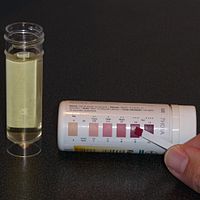
Photo from wikipedia
OBJECTIVE The aim of this study was to investigate seizure outcomes after resective epilepsy surgery following stereoelectroencephalography (SEEG), including group characteristics, comparing surgical and nonsurgical groups and assess predictors of… Click to show full abstract
OBJECTIVE The aim of this study was to investigate seizure outcomes after resective epilepsy surgery following stereoelectroencephalography (SEEG), including group characteristics, comparing surgical and nonsurgical groups and assess predictors of time to seizure recurrence. METHODS Clinical and EEG data of 536 consecutive patients who underwent SEEG at Cleveland Clinic Epilepsy Center between 2009 and 2017 were reviewed. The primary outcome was defined as complete seizure freedom since the resective surgery, discounting any auras or seizures that occurred within the 1st postoperative week. In addition, the rate of seizure freedom based on Engel classification was determined in patients with follow-up of ≥ 1 year. Presumably significant outcome variables were first identified using univariate analysis, and Cox proportional hazards modeling was used to identify outcome predictors. RESULTS Of 527 patients satisfying study criteria, 341 underwent resective surgery. Complete and continuous seizure freedom after surgery was achieved in 55.5% of patients at 1 year postoperatively, 44% of patients at 3 years, and 39% of patients at 5 years. As a secondary outcome point, 58% of patients achieved Engel class I seizure outcome for at least 1 year at last follow-up. Among surgical outcome predictors, in multivariate model analysis, the seizure recurrence rate by type of resection (p = 0.039) remained statistically significant, with the lowest risk of recurrence occurring after frontal and temporal lobe resections compared with multilobar and posterior quadrant surgeries. Patients with a history of previous resection (p = 0.006) and bilateral implantations (p = 0.023) were more likely to have seizure recurrence. The absence of an MRI abnormality prior to resective surgery did not significantly affect seizure outcome in this cohort. CONCLUSIONS This large, single-center series shows that resective surgery leads to continuous seizure freedom in a group of patients with complex and severe pharmacoresistant epilepsy after SEEG evaluation. In addition, up to 58% of patients achieved seizure freedom at last follow-up. The authors' results suggest that SEEG is equally effective in patients with frontal and temporal lobe epilepsy with or without MRI identified lesions.
Journal Title: Journal of neurosurgery
Year Published: 2021
Link to full text (if available)
Share on Social Media: Sign Up to like & get
recommendations!